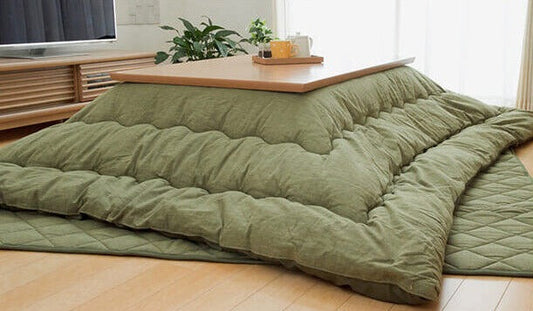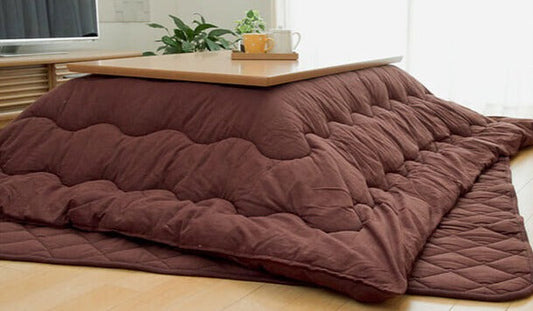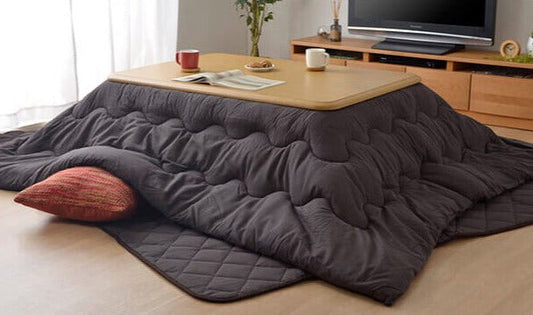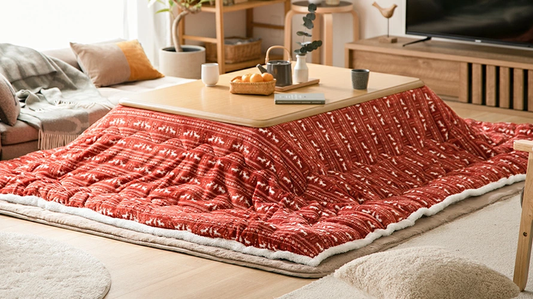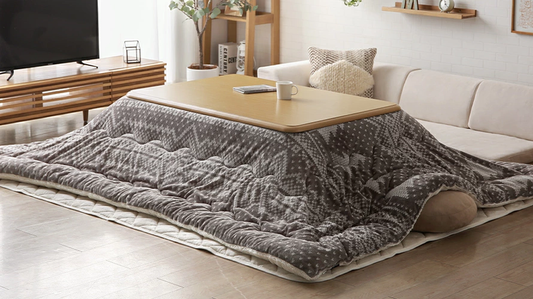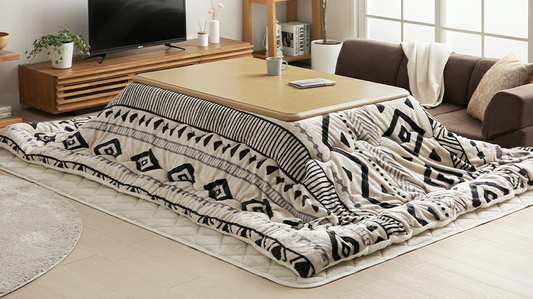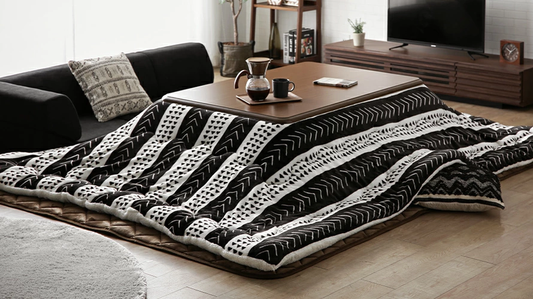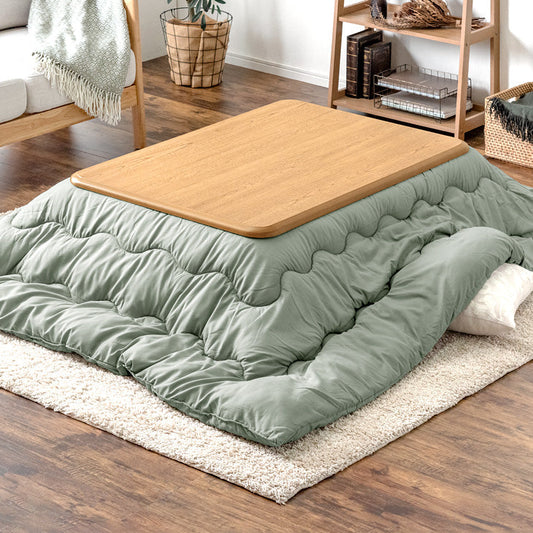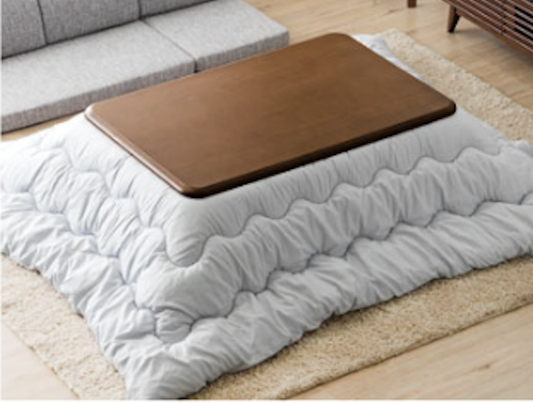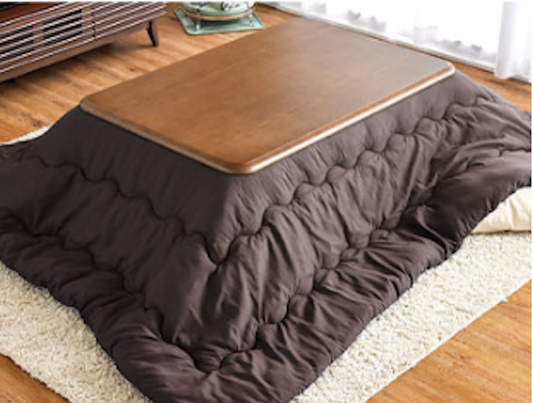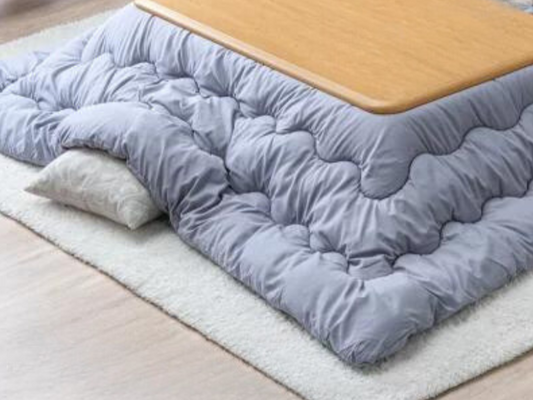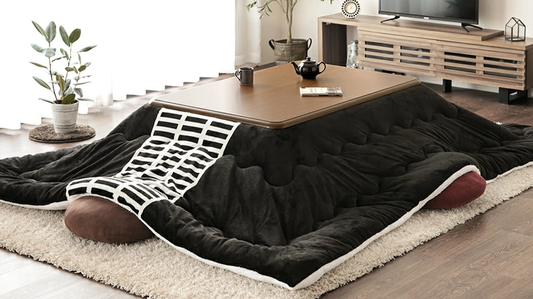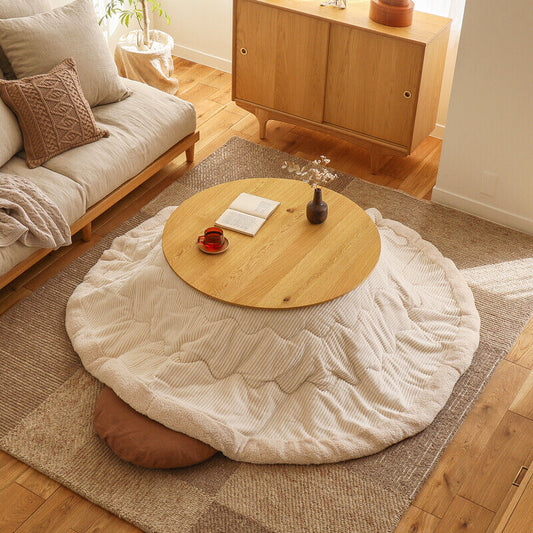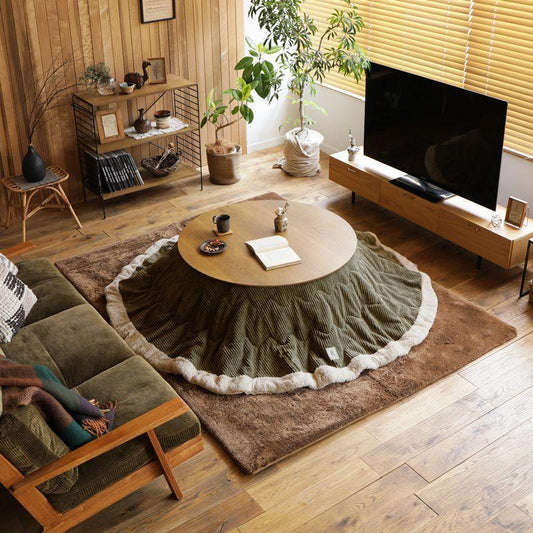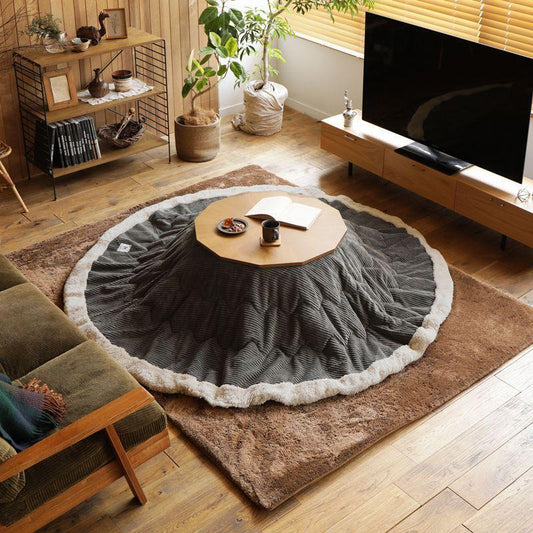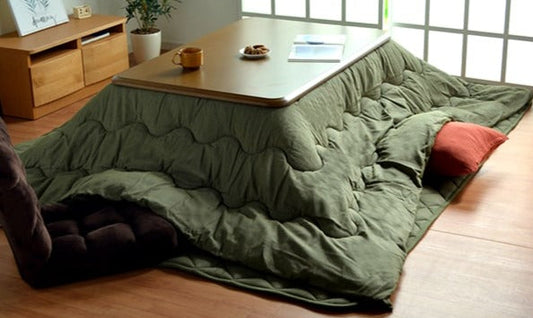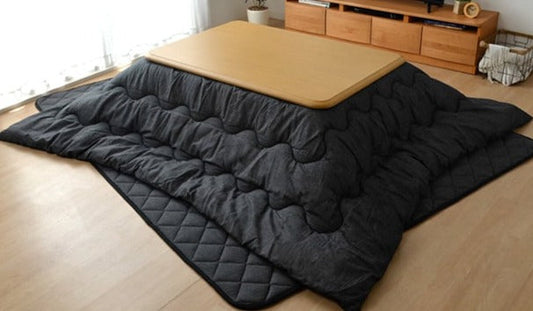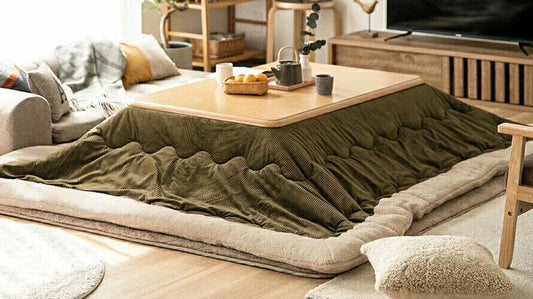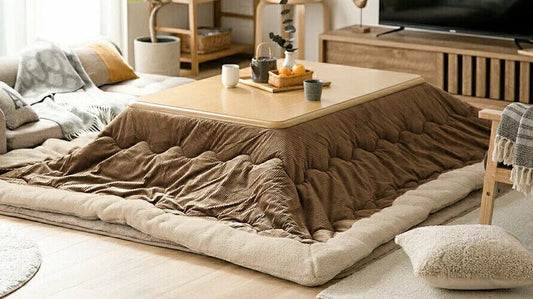The kotatsu stands as one of Japan's most brilliant contributions to home comfort, embodying the perfect fusion of functionality, tradition, and everyday practicality. At its core, a kotatsu is a low-standing heated table that has remained an integral part of Japanese domestic life for centuries, offering warmth and comfort during the cold winter months while serving as a central gathering point for families.
The Historical Evolution of Kotatsu
The development of the kotatsu represents a fascinating journey through Japanese history, reflecting the ingenuity and adaptability of Japanese culture in creating practical solutions for daily life. This heating system's evolution spans several centuries, demonstrating how traditional concepts can evolve to meet changing societal needs while maintaining their essential cultural significance.
Origins in the Muromachi Period

The story of the kotatsu begins in the Muromachi Period (1336-1573), a time of significant cultural development in Japan. During this era, the foundation for many elements of traditional Japanese culture was established, including tea ceremony, ink painting, and various aspects of domestic life. The original concept of the kotatsu emerged as a creative solution to Japan's cold winters, particularly in traditional homes that were built primarily for ventilation during hot summers rather than warmth in winter.
The Muromachi Period saw the beginnings of what would become the kotatsu in the form of a covered hearth system. This period was crucial in Japanese architectural history, as it marked the transition from the more primitive heating methods to more sophisticated approaches to maintaining warmth in Japanese homes.
The Irori: The Ancient Hearth
The predecessor to the kotatsu was the irori, a traditional sunken hearth that served as the central heating and cooking source in Japanese homes. The irori was essentially a square pit dug into the floor, lined with stone or clay, where a charcoal fire would be maintained. Above the irori, families would often hang pots for cooking and drying items.

The transition from irori to kotatsu began when people discovered that they could more efficiently capture and utilize the heat by suspending a wooden platform over the irori and draping it with heavy blankets. This innovation marked the first step toward the modern kotatsu, as it demonstrated the principle of containing and directing heat for more efficient warming.
The Development of the Hori-gotatsu
The next significant evolution came with the development of the hori-gotatsu, or "dug-out kotatsu." This adaptation maintained the sunken aspect of the irori but was specifically designed for heating rather than cooking. The hori-gotatsu consisted of a pit dug into the floor with a frame placed around it to support a blanket and table top. This design proved more efficient than the irori for heating purposes, as it focused the heat directly on the people sitting around it rather than losing it to the general room space.
The hori-gotatsu represented a crucial step in the development of heating technology in Japan, as it marked the first time that heating was separated from cooking functions. This specialization allowed for better optimization of both heating and cooking methods.
Introduction of Portable Heating Sources
A major breakthrough in kotatsu development came with the introduction of portable heating sources. During the Edo period (1603-1867), as charcoal became more readily available and manufacturing techniques improved, portable charcoal braziers called hibachi began to be used more frequently. This innovation led to the development of the oki-gotatsu, or "placed kotatsu," which could be moved around the house as needed.
The portable nature of the oki-gotatsu represented a significant advance in home heating technology. No longer bound to a fixed location like the irori or hori-gotatsu, families could now bring their heat source to whatever room they were using. This flexibility made the kotatsu even more practical and popular among Japanese households.
The Age of Modernization
The most dramatic transformation in kotatsu history came with the introduction of electricity to Japanese homes in the early 20th century. The development of electric heaters revolutionized the kotatsu, making it safer, more convenient, and more efficient than ever before.
The first electric kotatsu appeared in the 1920s, but they became widely popular in the post-World War II period as Japan underwent rapid modernization. Electric kotatsu eliminated the need for charcoal, removing the risks of fire and carbon monoxide poisoning that had been concerns with traditional models. They also offered more consistent heating and the ability to control temperature precisely.
Technological Refinements
Throughout the latter half of the 20th century, kotatsu continued to evolve with technological improvements. Modern electric kotatsu incorporated safety features such as automatic shut-offs and overheat protection. The heating elements became more energy-efficient, and designs were refined to provide better heat distribution.
Manufacturers also began experimenting with different materials and styles, creating kotatsu that could blend with various interior design aesthetics while maintaining their traditional functionality. This period saw the introduction of different height options, allowing people to use the kotatsu with Western-style chairs rather than sitting on the floor.
Cultural Preservation Amid Innovation

Perhaps the most remarkable aspect of the kotatsu's historical development is how it has maintained its cultural significance while adapting to modern life. Despite the widespread adoption of central heating in Japanese homes, the kotatsu remains popular, suggesting that its appeal goes beyond mere practical heating considerations.
The evolution of the kotatsu reflects broader patterns in Japanese culture - the ability to adapt foreign technology and modern innovations while preserving traditional values and practices. This balance between innovation and tradition has allowed the kotatsu to remain relevant in contemporary Japanese society.
Today's kotatsu, while technically far removed from its irori ancestors, still serves many of the same social and cultural functions. It continues to be a gathering place for families, a symbol of domestic comfort, and a practical solution for staying warm during cold months. This continuity, maintained through centuries of technological and social change, speaks to the enduring wisdom of the kotatsu's basic concept.
As we look to the future, the kotatsu continues to evolve, with new innovations in energy efficiency and smart home technology being incorporated into designs. Yet its fundamental purpose - providing warmth and comfort while bringing people together - remains unchanged from its origins in the Muromachi Period, demonstrating the timeless nature of truly effective design solutions.
The Basic Structure
A kotatsu consists of three essential components working in harmony to create its unique heating system. The foundation begins with a wooden frame, typically standing between 30 to 40 centimeters high, which forms the table's base. This frame, traditionally crafted from wood, provides both stability and aesthetic appeal while housing the heating element underneath.
The second crucial component is the heavy blanket, known as a kotatsu futon. This specially designed coverlet drapes over the table frame, extending generously toward the floor on all sides. Unlike regular blankets, kotatsu futons are crafted with specific materials and weights designed to trap heat efficiently while remaining durable enough for daily use. Modern kotatsu futons often incorporate multiple layers, including heat-resistant materials near the heating element and softer, more comfortable fabrics on the outer surface.
Completing the assembly is the tabletop, which rests securely over the blanket and frame. This flat surface, typically made from wood or wood composite materials, transforms the heating unit into a functional table for everyday activities. The tabletop is designed to be removable, allowing for easy maintenance and seasonal storage.
The Heating Mechanism
At the heart of every kotatsu lies its heating source, which has evolved significantly over time. Modern kotatsu typically feature an electric heating element attached to the table frame's underside. This heating element, operating at a low wattage (usually between 200-600 watts), provides consistent warmth without excessive energy consumption. The heat generated rises and becomes trapped by the blanket, creating a warm microclimate under the table.
Today's kotatsu often include variable temperature controls, allowing users to adjust the warmth to their preference. Many models also incorporate safety features such as automatic shut-off mechanisms and overheat protection, making them considerably safer than their historical counterparts that relied on charcoal heating.
The Principle of Efficient Heating

What makes the kotatsu particularly ingenious is its approach to heating. Rather than attempting to warm an entire room, the kotatsu creates a localized zone of warmth, focusing heat where it's most needed - around people's lower bodies. This targeted heating approach proves remarkably efficient, especially in traditional Japanese homes that historically lacked central heating systems.
The physics behind a kotatsu's effectiveness is straightforward yet clever. As the heating element warms the air beneath the table, the heavy blanket prevents this heated air from escaping rapidly. The natural convection process creates a comfortable pocket of warm air, while the blanket's draping design allows users to trap this warmth around their lower body by sitting with their legs extended under the table.
Versatility in Daily Life
While the primary purpose of a kotatsu is to provide warmth, its design makes it extraordinarily versatile. The flat tabletop surface serves multiple functions throughout the day. Families can use it for dining, working, studying, or entertainment. This multipurpose nature has helped the kotatsu maintain its relevance in modern Japanese homes, where space efficiency is often crucial.
The height of a kotatsu is specifically designed to accommodate traditional Japanese sitting styles, whether on cushions (zabuton) or on tatami mats. However, many modern versions are compatible with low chairs or floor chairs, adapting to contemporary lifestyle preferences while maintaining their traditional functionality.
Comfort and Social Aspects

Beyond its practical heating purposes, a kotatsu creates what many Japanese people describe as a uniquely comfortable and cozy environment, known as "kotatsu-maki" (being wrapped in a kotatsu). This sensation goes beyond mere physical warmth, creating a psychological comfort that many find deeply relaxing and satisfying.
The design naturally encourages social gathering and interaction. By providing a warm, comfortable space where people can sit together for extended periods, the kotatsu has historically served as a focal point for family bonding, conversation, and shared activities. This social aspect remains one of its most valued characteristics, even in the age of modern heating systems.
The Science of Comfort
The effectiveness of a kotatsu in providing comfort stems from its targeted warming of the lower body. Human bodies are particularly sensitive to warming the extremities, and by keeping the feet and legs warm, a kotatsu creates a sensation of overall warmth even when the ambient room temperature remains relatively cool. This physiological response explains why users often feel comfortable while using a kotatsu even in unheated rooms.
The combination of gentle, radiating heat and the physical enclosure created by the blanket also produces a microclimate that many find ideal for relaxation. The warmth is neither as dry as forced-air heating nor as intense as direct radiant heaters, contributing to its reputation for comfortable, natural-feeling warmth.
The Anatomy of a Kotatsu
The kotatsu's effectiveness as a heating solution lies in its thoughtful construction and the careful integration of its various components. Understanding each element and how they work together reveals the ingenious engineering behind this traditional Japanese furniture piece. Let's explore the essential components that make up a kotatsu and examine how they contribute to its functionality and safety.
The Foundation: Table Frame
The table frame serves as the structural foundation of every kotatsu and plays a crucial role in its stability and durability. Traditionally crafted from solid wood, modern frames may also incorporate engineered wood products like medium-density fiberboard (MDF) or plywood for cost-effectiveness while maintaining structural integrity.
The frame typically features several key characteristics:
- Height ranges from 35 to 40 centimeters for traditional floor-sitting styles
- Reinforced corners for structural stability
- Pre-drilled mounting points for the heating element
- Cable management systems for electric models
- Support brackets for the tabletop
- Adjustable legs in modern versions for height customization
High-quality kotatsu frames often use hardwoods like oak, cherry, or walnut, chosen for their durability and aesthetic appeal. The wood must be properly seasoned and treated to prevent warping from heat exposure and humidity changes. Many manufacturers apply multiple layers of protective finish to guard against heat damage and extend the frame's lifespan.
The Thermal Barrier: Kotatsu Futon

The kotatsu futon, or blanket, is perhaps the most crucial component for the table's heating efficiency. This specialized blanket is engineered with multiple layers to provide optimal heat retention while ensuring safety and durability.
A typical kotatsu futon consists of several layers:
- Outer layer: Durable, stain-resistant fabric
- Middle layer: Insulating material (often polyester fiberfill)
- Inner layer: Heat-resistant material protecting against the heating element
- Edge binding: Reinforced stitching to prevent fraying
Modern kotatsu futons often incorporate advanced materials such as:
- Fire-resistant fibers
- Anti-bacterial treatments
- Moisture-wicking properties
- Static-resistant coatings
The size of the futon typically extends 25-35 centimeters beyond the table edges on all sides to ensure proper heat retention and comfort for users. Many manufacturers offer replaceable futons in various designs and colors to match different interior aesthetics.
The Functional Surface: Tabletop
The tabletop component must balance durability with practicality while complementing the overall design. Modern kotatsu tabletops are engineered to provide a stable surface while preventing heat damage and ensuring user safety.
Key features of kotatsu tabletops include:
- Heat-resistant materials and finishes
- Reversible design for seasonal use
- Rounded edges for safety
- Secure attachment mechanisms
- Ventilation considerations to prevent heat buildup
Common tabletop materials include:
- Composite wood products with heat-resistant laminate
- Solid wood with protective coating
- Modern materials like tempered glass or heat-resistant polymers
- Traditional materials like cedar or cypress in premium models
The Heart of the System: Heat Source
The heating element is the technical core of the kotatsu, and its design has evolved significantly from traditional charcoal to modern electric systems.
Traditional Charcoal Heating:
- Used special charcoal containers (hibachi)
- Required careful management for temperature control
- Needed regular ventilation
- Required specific safety protocols
Modern Electric Heating Elements:
- Power ratings typically between 200-600 watts
- Carbon fiber or similar heating elements
- Integrated temperature controls
- Even heat distribution design
- Energy-efficient operation
- Multiple heat settings
Kotatsu Types: Traditional and Modern Variations
The kotatsu, an integral part of Japanese home life, has evolved significantly over the centuries to accommodate changing lifestyles and living spaces. While maintaining its core purpose of providing warmth and comfort, different types of kotatsu have emerged to suit various needs and preferences. Let's explore the main categories and their distinct characteristics that make each type unique.
The Versatile Platform Style (Okigotatsu)

The okigotatsu represents the most common and adaptable form of kotatsu in contemporary Japanese homes. This freestanding version, whose name literally means "placed kotatsu," has become the standard choice for modern living spaces. Its popularity stems from its remarkable versatility and practical design, allowing users to place it anywhere in their homes without permanent installation.
What makes the okigotatsu particularly appealing is its portability. Standing typically between 35 to 40 centimeters high, these tables can be easily moved from room to room, offering flexibility in home arrangement. During warmer months, families can disassemble and store their okigotatsu, freeing up valuable living space. Modern manufacturers have enhanced this convenience by incorporating features like fold-down legs and built-in cord storage compartments, making seasonal transitions smoother than ever.
The Traditional Hole-in-Floor Style (Horigotatsu)
In contrast to the portable okigotatsu, the horigotatsu represents a more traditional approach to kotatsu design. This style, featuring a sunken floor area for legs, remains popular in traditional Japanese restaurants and homes, particularly those with dedicated washitsu (traditional Japanese rooms). The horigotatsu creates an authentic Japanese dining and lounging experience that many find deeply appealing.
The construction of a horigotatsu involves creating a permanent floor cavity, typically 40 to 50 centimeters deep, with a built-in frame around the perimeter. This design offers superior heat efficiency as the sunken area naturally contains warmth better than its above-floor counterparts. The permanent installation also provides enhanced stability and often more spacious leg room, making it particularly comfortable for extended periods of use.
Modern Variations and Contemporary Design

Contemporary kotatsu design has expanded far beyond traditional boundaries, embracing modern aesthetics and technology while maintaining the fundamental principles of this beloved piece of furniture. Designer kotatsu now feature sleek lines, premium materials, and artistic elements that complement modern interior décor. Some high-end models incorporate smart heating controls, USB charging ports, and even LED lighting systems, bringing this traditional furniture piece firmly into the 21st century.
Space-saving innovations have led to the development of corner designs and wall-mounted options, perfect for urban dwellers with limited living space. Family-sized variations offer extended table surfaces and multiple heating zones, while compact models cater to single users or couples in smaller apartments. Some manufacturers have even created hybrid designs that combine kotatsu functionality with other furniture types, such as desk combinations or sofa-integrated models.
The most successful modern variations maintain a careful balance between innovation and tradition. While they may incorporate new technologies and materials, they preserve the essential qualities that have made the kotatsu a beloved feature of Japanese homes for centuries. These contemporary designs often feature improved heating efficiency, better safety features, and more durable construction while retaining the cozy, communal atmosphere that kotatsu are famous for.
Kotatsu Maintenance and Care
Proper maintenance and care of a kotatsu are crucial for ensuring its longevity, safety, and optimal performance. Like any piece of furniture that combines electrical components with daily use, a kotatsu requires regular attention and appropriate maintenance procedures. This comprehensive guide will help you keep your kotatsu in excellent condition throughout its lifetime.
Regular Cleaning and Daily Care
Daily maintenance of a kotatsu begins with simple but essential cleaning practices. The tabletop, being the most frequently used surface, requires particular attention. Wipe it down after each use with a slightly damp cloth to remove any food particles, dust, or spills. For wooden tabletops, avoid using excessive water, as this can damage the finish or cause warping. Instead, use cleaning products specifically designed for wooden furniture, applied with a soft cloth.
The frame requires regular dusting to prevent buildup that could affect the heating element's efficiency. Pay special attention to the corners and joints where dust tends to accumulate. For deeper cleaning, use a vacuum cleaner with a brush attachment to remove dust from hard-to-reach areas. If the frame becomes stained, clean it carefully with a wood cleaner appropriate for your kotatsu's finish, being mindful to avoid any contact with electrical components.
Blanket Maintenance

The kotatsu blanket or futon requires special care to maintain its heat-retention properties and cleanliness. Most manufacturers recommend washing the blanket at least twice during the usage season, following specific care instructions. Generally, this involves machine washing on a gentle cycle with mild detergent and thorough drying to prevent mold growth.
Between washes, regular airing of the blanket helps maintain freshness and eliminate any accumulated moisture. On sunny days, take the opportunity to hang the blanket outdoors for a few hours. This natural airing process not only freshens the fabric but also helps maintain its insulating properties. Before returning the blanket to the kotatsu, ensure it is completely dry to prevent any risk of electrical hazards or mold growth.
Off-Season Storage
When warm weather arrives, proper storage of your kotatsu becomes essential for maintaining its condition. Begin by thoroughly cleaning all components and ensuring they are completely dry. Disassemble the kotatsu carefully, keeping track of all parts and fasteners. The heating element should be carefully wrapped and stored in a dry place, protected from dust and moisture.
For the blanket, clean and dry it thoroughly before storage. Consider using vacuum storage bags to protect it from dust and insects while saving space. The tabletop and frame should be stored in a cool, dry place, away from direct sunlight to prevent warping or fading. If possible, store wooden components horizontally to maintain their shape and prevent strain on joints.
Electrical Component Care

The heating element and electrical components require careful attention to maintain safety and efficiency. Regular inspection of the power cord for any signs of wear, damage, or fraying is essential. Check the heating element housing for any signs of damage or overheating, such as discoloration or warping.
Clean the heating element housing carefully with a dry cloth to remove dust accumulation, which can affect heating efficiency and potentially create fire hazards. Never use water or liquid cleaners on electrical components. If you notice any unusual sounds, smells, or performance issues, discontinue use immediately and have the unit inspected by a qualified professional.
Safety Checks and Maintenance
Regular safety checks should become a routine part of your kotatsu maintenance schedule. Before each heating season, perform a thorough inspection of all components:
Test the temperature control mechanism to ensure it functions properly across all settings. Check all connections between components, ensuring they are secure and properly aligned. Inspect the frame for any loose joints or damage that could affect stability. Verify that all safety features, such as automatic shut-off mechanisms, are working correctly.
Pay particular attention to the area where the power cord enters the heating unit, as this is a common point of wear. If you notice any damage or deterioration, have it repaired by a qualified technician before using the kotatsu.

